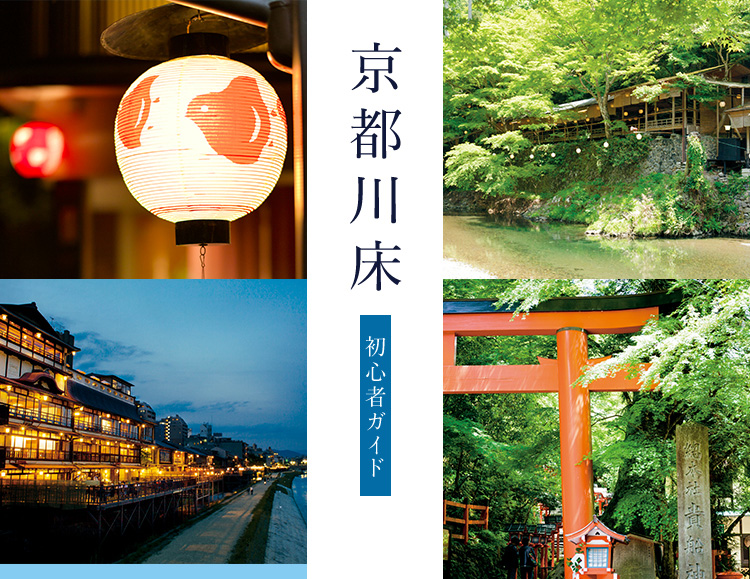Kyoto kawayuka areaKyoto Kawadoko areaIntroduction of places and means of transportation

The “Kawadoko” that colors the summer in Kyoto can be roughly divided into three areas.
“Kamogawa” is a tourist spot with excellent access in the city, “Kifune” is an inner parlor in Kyoto where you can enjoy the extraordinary, and “Takao” is also known as a famous spot for autumn leaves surrounded by nature.
We will introduce how to access the three areas.
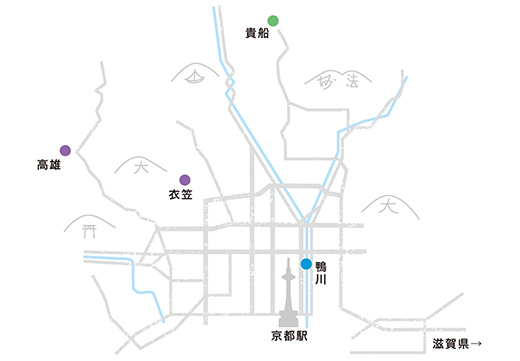
Kamogawa nouryouyukaKamogawa Noryo-doko
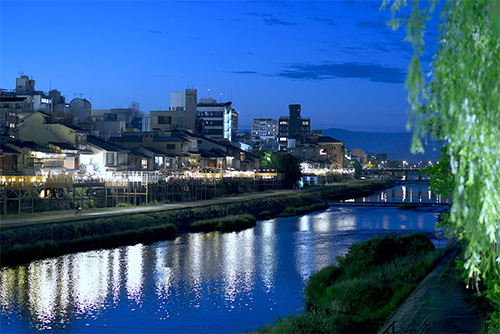
-
When you think of Kawadoko, you might think of authentic Japanese cuisine and Kyoto cuisine, but Kamogawa Noryodoko has a variety of restaurants such as French, Italian, Chinese, izakaya-style, cafes, etc. There are many shops that are easy to visit even for beginners.
And above all, you can enjoy it in the city of Kyoto, so access is outstanding.
AccessIntroduction of transportation
-
How to access by train
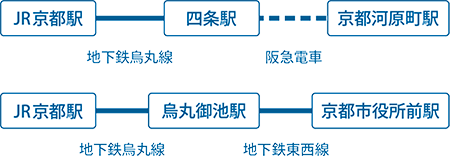
Each line Kyoto Station → Subway Karasuma Line "Shijo" station → Hankyu Railway "Kyoto Kawaramachi" station get off.
Alternatively, Kyoto Station on each line → Subway Karasuma Line "Karasuma Oike" station → Subway Tozai Line "Kyoto Shiyakusho-mae" station (about 20 minutes). After getting off at each station, walk to Kiyamachi-dori and Ponto-cho, which are one street west of Kamogawa.
-
Access by bus

From Kyoto Station on each line, take the city bus and get off at "Kawaramachi Gojo", "Shijo Kawaramachi", or "Kyoto Shiyakushomae" (about 25 minutes).
After getting off, walk to Kiyamachi-dori and Ponto-cho, which are one block west of Kamogawa.
KibuneKifune
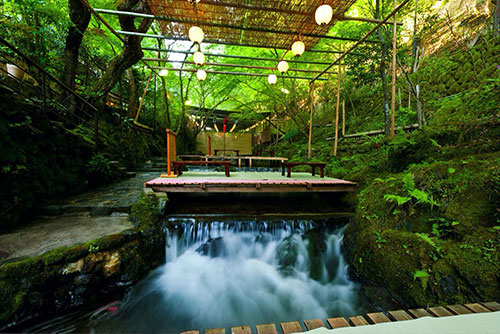
-
Kifune Kawadoko is located along the Kifune River in front of Kifune Shrine, heading north on the Eizan train. In Kibune, the riverbed is set up immediately on the water surface, so it is said that the sensible temperature is 10 degrees lower than in central Kyoto, making it a popular summer resort. Kawadoko, where you can enjoy sweetfish and conger eel while listening to the sound of spraying water, is very popular with tourists.
AccessIntroduction of transportation
-
How to access by train
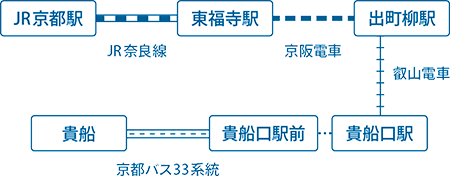
Kyoto Station on each line → JR Nara Line "Tofukuji" Station → Keihan Railway "Tofukuji" Station → "Demachiyanagi" Station → Eizan Railway "Demachiyanagi" Station → Get off at "Kifuneguchi" Station. Kyoto Bus Route 33 "Kifuneguchi Ekimae" → Get off at "Kifune" (about 60 minutes)
-
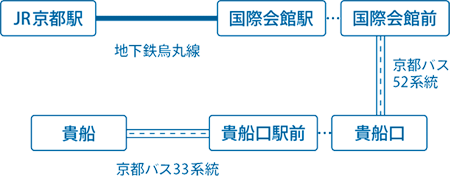
Kyoto Station on each line → Get off at Subway Karasuma Line Kokusaikaikan Station. Take the Kyoto Bus No. 52 "Kokusaikaikan-mae" → get off at "Kifuneguchi". Kyoto Bus Route 33 "Kifuneguchi Ekimae" → Get off at "Kifune" (about 60 minutes)
-
Access by bus
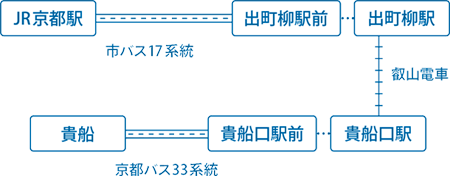
-
Kyoto Station on each line → City Bus No. 17 and get off at "Demachiyanagi Ekimae". Eizan train "Demachiyanagi" station → "Kifuneguchi" station. Kyoto Bus Route 33 "Kifuneguchi Ekimae" → Get off at "Kifune" (about 60 minutes)
TakaoTakao
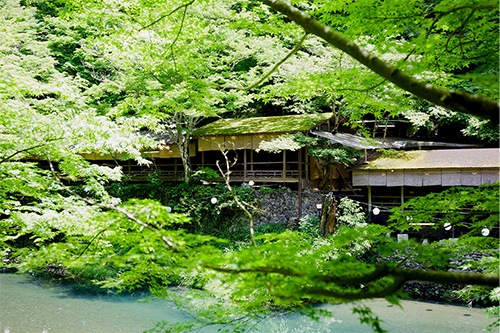
-
If you head west from Kyoto city for about an hour, you will arrive at the Takao area surrounded by green maple. Kawadoko in Kaohsiung are characterized by roofs, so you can enjoy a resort atmosphere that is different from the Kamogawa Noryodoko in the city. In terms of enjoying nature, we also recommend Kawadoko in the Kinugasa area of Kita Ward, Kyoto City.
AccessIntroduction of transportation
-
How to access by train

Kyoto Station on each line → Get off at Hanazono Station on the JR Sagano Line. About 10 minutes by taxi. (about 25 minutes)
-
Access by bus

Each line Kyoto Station → West Japan JR Bus Takao/Keihoku Line "Yamashiro Takao" get off. (about 60 minutes)
Kyoto kawayuka mannersKyoto Kawadoko Manor10 points you should know

Perfect for beginners! We will teach you 10 points to fully enjoy your meal on the kawadoko from the time you make a reservation to the time you leave.
Kawadoko Debut doesn't have to think too hard.
-

-
Kawadoko seat reservation
First, make a note and call so that you don't miss any confirmation items or wishes. Kawadoko season is very popular, so it is recommended to make a reservation as early as possible.
-
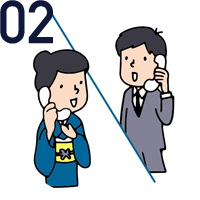
-
Easy time to consult
If you take the phone out of business hours when you are busy with customer service, it will be easier for you to consult. Let's get rid of what we want to convey and anxiety at this time.
-
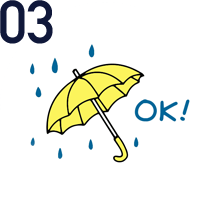
-
Cancellation at the last minute in the rain is NG
Seats are provided inside the store, so don't worry if it rains. Enjoy the emotional private room, and the Kawadoko next time.
-
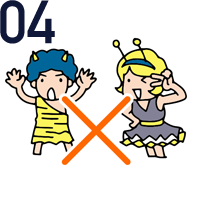
-
clothes
We want you to enjoy the atmosphere of the kawadoko seat carefully, so it is prohibited to wear clothes that do not suit the occasion. If you're a woman, imagine how you'll dress to meet his mom.
-
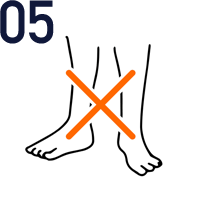
-
Avoid bare feet
There are many Japanese restaurants where trays are placed on the tatami mats, so please refrain from wearing bare feet even if you take off your shoes.
-
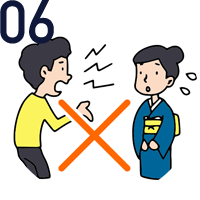
-
seats are limited
Seats on the river bank facing the river are limited, so don't overdo it and embarrass the store staff. The north side near the Imperial Palace, along the river bank, is worthy of honor.
-
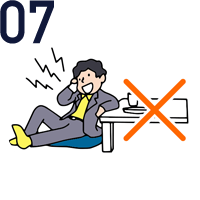
-
dining manners
You don't have to think about it stiffly, but it might be a good idea to prepare with a manners book. Basics are OK as long as you behave within the bounds of common sense.
-
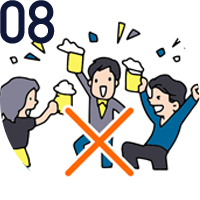
-
No fuss
Even though the restaurant is usually casual, the Kawadoko is adjacent to the restaurant next door. Be polite enough to hear the babbling of the river.
-
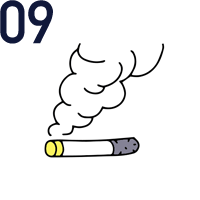
-
tobacco
The river bed is outside, so the wind blows. Smoke often drifts to people around you, so please be considerate even if smoking is allowed.
-
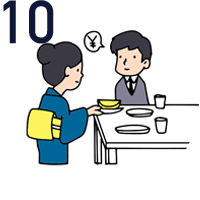
-
accounting timing
Kawadoko, where it is difficult to speak loudly to the store staff. If it's a course, when the water (fruit) comes out, it signals the end. It is recommended to ask for the bill at that time.
Kyoto kawayuka Q&AKyoto Kawadoko IrohaThorough dissection of questions

"Kawadoko" is popular as a summer tradition in Kyoto.
"How to pronounce kawadoko correctly?" "Is it okay to go alone?" "When did kawadoko first start?"
We asked Kyoto Kamogawa Noryodoko Cooperative Association to answer questions for Kawadoko beginners!
 When did Kawadoko start?
When did Kawadoko start?-
 It started in the early Edo period. It has a history of 400 years.
It started in the early Edo period. It has a history of 400 years.-
It is said to have originated in the transition period from Hideyoshi's era to the Edo period, when wealthy merchants set up spectator seats and teahouses along the banks of the Kamogawa River. In the mid-Edo period, teahouses arranged floors on sandbars in the shallows, and there were overhanging types, which were called 'kawara no ryomi'. During the Taisho period, due to the extension of the Keihan Oto Line, etc., the floor is only on the west bank. After World War II, the floor disappeared completely, but in 1951, the Kyoto Prefectural Assembly issued a notification and made a comeback. When the Kamogai Hoshokai was formed in 1953, there were 30 to 40 Noryodoko. Today, the number doubles to nearly 100.
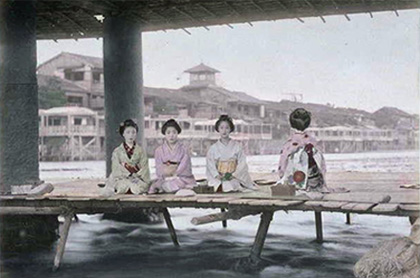
-
Kifune started in the Taisho era
During the Taisho period, when the present-day Japanese inn, Fujiya, was running a tea house, it began as a place to entertain guests on floors about the size of 5 to 6 shaku tatami mats in the Kibune River. At that time, the main way to enjoy the river was to cool off while drinking tea, and the food was served in the room. Before long, it became popular with customers and food was served on the river, and Kurama trains and buses were opened, linking the area with the city, and the reputation of Kawadoko increased. After the war, the number of shops gradually increased, and "Kifune no Kawadoko" became known as a popular tourist destination.
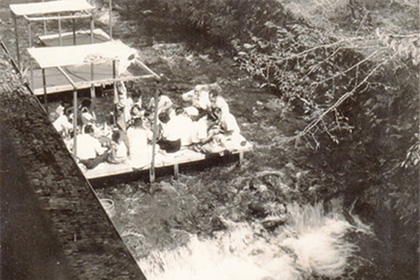
-
 Is it true that there are two names for kawadoko, kawayuka and kawadoko?
Is it true that there are two names for kawadoko, kawayuka and kawadoko?-
 "Yuka" is the correct answer for Kamogawa Noryo-Yuka.
"Yuka" is the correct answer for Kamogawa Noryo-Yuka.-
The Kamogawa Noryodoko is called "Yuka", and the Kawadoko in Kibune and Takao is called "Kawadoko". There are various theories about the origin of the name, but in the case of the Kamogawa, I believe that it is a "floor" because the floor protrudes from the floorboards of the building. It is also conceivable that different names are used to distinguish the kawadoko in each region. We hope that customers will take this opportunity to remember the Kamo River as “Yuka”.
-
 Is it okay to go to the river bed alone?
Is it okay to go to the river bed alone?-
 There is a floor that can be used casually by yourself.
There is a floor that can be used casually by yourself.-
When you think of kawadoko, you may have a strong image of Kyoto cuisine, but in fact, there are various genres of restaurants such as French, Italian, and Chinese cuisine, as well as izakaya, bars, and cafes. In other words, there are restaurants that offer course meals that can be reserved for two or more people, and restaurants that allow you to stop by on your own. Find a shop that meets your needs from the association's website, etc., and enjoy the Kawadoko.
-
 Are there times when the riverbed is crowded? This is the target! I would like you to tell me that there are times such as
Are there times when the riverbed is crowded? This is the target! I would like you to tell me that there are times such as-
 We recommend July and August, when you can experience the cool evening breeze.
We recommend July and August, when you can experience the cool evening breeze.-
Floor seats are popular at any time of year, but July and August are the recommended times. After the rainy season is over, it is less likely that you will give up on the kawadoko that you have been looking forward to because of the rain. Also, because it is a hot and humid season, I think you will be able to experience the coolness that is the real pleasure of the kawadoko. If you wish to have a floor seat, we recommend making a reservation in advance if the restaurant allows reservations. Please note that some restaurants require reservations.
-
-
select by area
-
choose by scene
-
Select by genre


